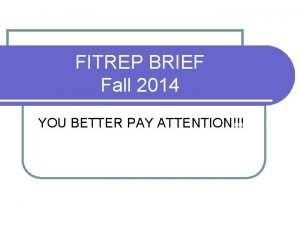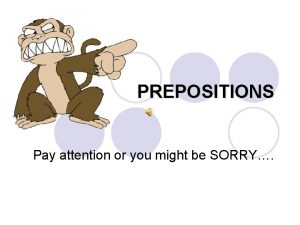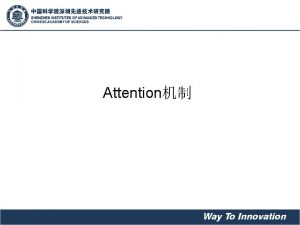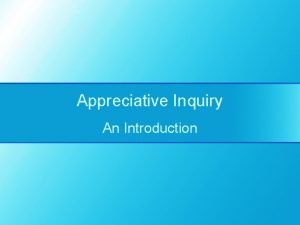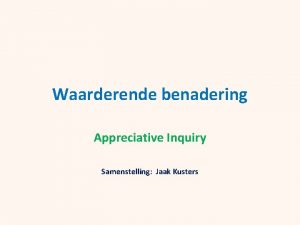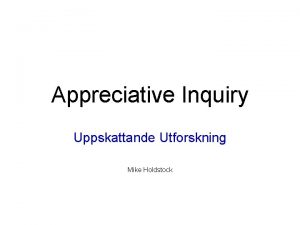Appreciative Analysis of Practices Everything you pay attention










- Slides: 10

Appreciative Analysis of Practices “Everything you pay attention to grows”

What is Wanda? (Valuing – Analyzing – Doing) �Co-reflection method (group) (Bove, 2009; Mortari, 2009) �Critical analysis of practices from different perspectives

Goal Gaining new insights and new practices → improving quality for children, families, staff (wellbeing) through a reflection process

Wanda in practice

Wanda = • 5 steps to reflect on a situation from different perspectives • Within one session of 1, 5 -2 hours – every 4 -6 weeks • A guided process by a facilitator • Working on confidentiality and safety (process) • Accentuating professional and institutional change • Part of a bigger process

Phase 1: Looking back � What do we still remember about the last session? � What did we learn from the session? � Did we put anything in practice? Ø Ø Contributor Group � Only applicable after the group has already done at least one previous session

Phase 2: Selecting a case � Situation that “moved/surprised/shocked” something inside the person � Concrete case (like explaing a photograph) � The group decides which case will be handled Ø Ø Urgency Group value � The contributor is the “owner” of the case and has a specific question (can still be undefined in this phase)

Phase 3: Questioning � Explorative open questions (who, where, what, when, how) to make the case more clear � Questions about all the people involved and the context � No interpretation or judgment � Try to find out why the contributor selected this case, what is his need? Ø Ø We don’t change the others, we change our perspective on the situation Try to define the positive learning question of the contributor

Phase 4: Collecting ideas � What are the possible different perspectives, usefull in this case? � Use glasses, or any other method to help participants to take the position of somebody else � What are all the possible different hypothesis’s � It is not about who is right or wrong � Contributor listens

Phase 5: Giving various kinds of advise �New possible ways to proceed with this situation �Advice on different levels: Ø To the contributor, Ø To the team, Ø To the organisation �Not ‘the’ solution but opportunities to explore �Contributor chooses which advices he wants to put into action
 Please pay attention what your teacher says
Please pay attention what your teacher says Fitrep block 41 examples
Fitrep block 41 examples Michelle benjamin phd
Michelle benjamin phd You are my lord
You are my lord Pay attention the teacher's instructions
Pay attention the teacher's instructions Preposition with attention
Preposition with attention Keep the soul alive
Keep the soul alive John roberto
John roberto What is the subject of the announcement
What is the subject of the announcement Write the spanish translations to the following sentences
Write the spanish translations to the following sentences What should be given attention in this style
What should be given attention in this style

